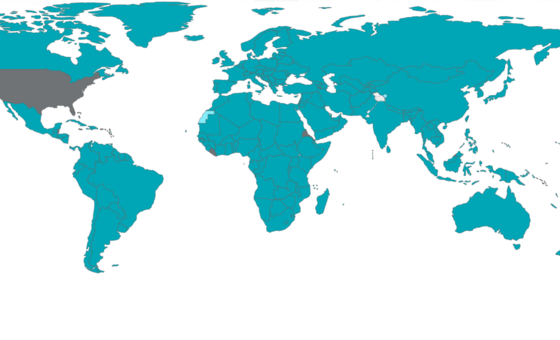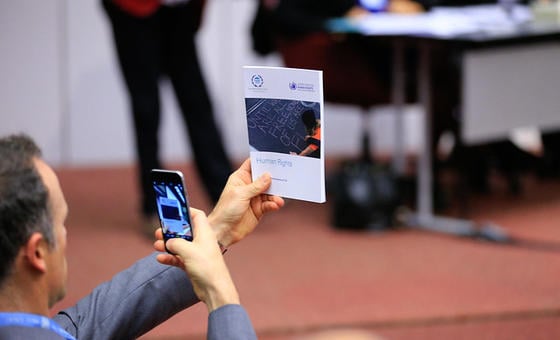- ImpactL'UIP facilite la diplomatie parlementaire et donne aux parlements et aux parlementaires les moyens de promouvoir la paix, la démocratie et le développement durable dans le monde.Nous aidons les parlements à devenir plus soucieux de l'environnement et à mettre en œuvre l'Accord de Paris.L'UIP contribue au renforcement des parlements afin de les rendre plus efficaces et plus représentatifs.Nous nous attachons à accroître la représentation des femmes au parlement et à autonomiser les femmes parlementaires.L'UIP défend les droits des parlementaires et les aide à faire respecter les droits de tous.Nous aidons les parlements à lutter contre le terrorisme, la cyber-guerre et la prolifération des armes de destruction massive.Nous encourageons la représentation des jeunes dans les parlements et autonomisons les jeunes parlementaires.Nous soutenons les parlements dans la mise en œuvre des ODD, en particulier dans les domaines de la santé, du commerce et des changements climatiques.
- ParlementsPresque tous les pays du monde ont un parlement. Les systèmes parlementaires se divisent en deux catégories : bicaméraux et monocaméraux. Sur 190 parlements nationaux dans le monde, 78 sont bicaméraux (156 chambres) et 112 sont monocaméraux, soit un total de 268 chambres parlementaires comprenant environ 44 000 membres. L'UIP compte 179 membres. Vous trouverez ici toutes les informations sur
Trouver un parlement national
L'UIP contribue au renforcement des parlements afin de les rendre plus efficaces et plus représentatifs. - ÉvénementsRéunion en ligneLa Cour internationale de justice (CIJ) a été constituée en vertu de la Charte des Nations Unies pour aider les nations à régler pacifiquement leurs différends dans le respect du droit international.Tout au long de l'année, l'UIP et ses Membres organisent de nombreux événements pour permettre aux parlementaires d'échanger leurs bonnes pratiques, d'obtenir les informations les plus récentes et de définir des moyens d'action.
- RessourcesL'UIP recueille des données sur les parlements depuis sa création en 1889, notamment sur la participation des femmes à la vie politique depuis 1945. Dans cette section, découvrez la base de connaissances de l'UIP sur les parlements et à leur sujet.
Découvrez les ressources de l'UIP
Notre bibliothèque de ressources essentielles pour les parlements et à leur sujetVotre portail unique de données sur les parlements nationauxDernières données et rapports sur la participation des femmes à la vie politiqueResolutions, declarations and outcomes adopted by IPU MembersInnovations récemment introduites par les parlements dans leur façon de travaillerLa base de données sur la législation en matière de changements climatiques de la London School of Economics
Contracted service
Development of a website for the Indicators for democratic parliaments
The Inter-Parliamentary Union and its partners are seeking to develop a new online presence for the rollout and uptake of the Indicators for Democratic Parliaments. This multi-lingual website will be used to promote the Indicators, incorporate a tool to help users explore, understand and use the Indicators, and provide a space to build knowledge and support learning in their adoption. We are seeking proposals from agencies who can quickly help us move forward to deliver a website that meets these aims.
The website itself will be made live on 16th October 2023 and launched the following week at our international Assembly.
1.1 About the Indicators
The United Nations Sustainable Development Goal 16 recognizes the importance of strong institutions, including strong parliaments, and has created the need to help parliaments to evaluate their progress against this goal. Of particular relevance are targets 16.6 (Develop effective, accountable and transparent institutions) and 16.7 (Ensure responsive, inclusive, participatory and representative decision-making), which are in line with the IPU’s own criteria for democratic parliaments.
Since 2019, IPU has worked in collaboration with eight partners to draft the set of Indicators. The 25 indicators are structured around the SDG sub-targets, which are:
- Effective Parliament
- Accountable Parliament
- Transparent Parliament
- Responsive Parliament
- Inclusive Parliament
- Participatory Parliament
- Representative Parliament
The indicators have a regular structure and are broken down into 111 dimensions, and around 500 assessment criteria. These are brought together into a self-assessment tool and supporting materials which allow parliaments to grade the extent to which they fulfil the criteria for each indicator.
The primary purpose of the Indicators is to support parliaments’ ability to learn and improve, and ultimately to strengthen parliaments and enhance democracy. They will be legally owned by the IPU, but jointly published by IPU and project partners under a creative commons licence, allowing users to freely reuse, reproduce, or translate the Indicators, in whole or in part, with requisite attribution.
1.2 About IPU
The IPU is the global organisation of national parliaments. We empower parliaments and parliamentarians to promote peace, democracy and sustainable development.
Strong, democratic parliaments are essential to this mission. IPU has historically developed standards and guidelines to support parliaments in strengthening their institution and our 2022-2026 IPU Strategy sets out a number of strategic objectives in this area. More information about IPU and our objectives is available on the organisation’s website www.ipu.org/impact
IPU is the convenor for the Indicators for Democratic Parliaments project. The project brings together the main organisations working in parliamentary development to create a common tool for the parliamentary community worldwide.
1.3 Audiences
The Indicators and associated materials are a public good, available to anyone who wishes to use them. They are primarily intended for parliaments, their members and staff, including Modernization and Business Committees, library and research services and procedural services. The site will promote the existence and purpose of the Indicators, and advocate for their use to strengthen parliaments.
The indicators are expected to become a major reference source for parliaments themselves, and also for governments, parliamentary strengthening organisations and other local or international organisations, donors, researchers and civil society actors interested in developing stronger democratic institutions, or holding these institutions to account. To this end, civil society organisations may wish to carry out their own assessments in parallel with parliament’s own exercise.
1.4 Project aims
One of our partners, NDI, built a dedicated website in 2022, hosted at www.parliamentaryindicators.org. to provide access to the preliminary version of the Indicators as part of a public consultation process.The site shares information about the project, describes the indicators, and encourages testing and feedback on using the indicators. Parliaments are able to download the indicators as static documents to trial usage within their own parliament, view video guidance on use, and provide feedback via a contact form.
We are at a milestone where the indicators will shortly be fully signed off and ready for publication. The project will therefore require promotional activities, communication planning and development of design and branding materials to support uptake, and wholescale redevelopment of the website to host the Indicators and provide an effective resource for parliaments.
The Indicators are published on behalf of the entire “parliamentary community”. The website will be the “home base” for the Indicators and the primary means by which users discover and interact with them. It is important that the Indicators website reflects that multi-partner characteristics of the project, and enables partner organizations to incorporate it into their work with parliaments.
2. Website planning and development
2.1 Website requirements
The site should advocate for use of the Indicators through
- effective communication of the purpose, benefits and impact of the Indicators to key audiences,
- publication of the Indicators in clear, accessible, formats, and
- provision of access to support services and guidance in their use.
The site should be visually attractive, using suitable infographics and colours, with an approach which makes the content as accessible as possible. The key components envisaged for the website are:
2.1.1 Interactive Indicator explorer and navigation tools
The core of the website will be an interactive digital version of the Indicators. The well-organised, hierarchical structure of the Indicators will be migrated to the site and presented to users. The site will:
- Make it easy to explore and understand the indicators themselves, through an intuitive and engaging interface, and navigation tools which support both linear browsing and cross-linkages between the Indicators.
- Host supporting guidance documents and background reading for different aspects to support assessments. These will be available both from the relevant location, and from a stand-alone searchable document library containing contents summaries and bibliographic or citation information such as publisher, author, publication dates, and language versions.
- Allow users to describe and suggest new materials to add to the library.
- Provide access to a downloadable self-assessment scoring tool being developed by IPU in Microsoft Excel format, which will allow users to record their scores and track progress.
- Allow users to download off-line (PDF and Word) versions of selected indicators, along with specific supporting materials to support their assessment activities.
- Provide the functionality for users to feedback and submit questions and suggestions at each stage of their assessment, with the ability to share aspects of assessments with IPU support teams.
2.1.2 Advocacy materials
The site will promote uptake of the Indicators through:
- Engaging, clear and concise messaging and website copy which speaks to our key audiences and explains and encourages use of the Indicators.
- Publication and/or commissioning of a ‘showcase’ which presents narratives or case studies that communicate how parliaments have used the Indicators and implemented change. Our first case study could be the Pakistan Senate.
- Summary information about the uptake and usage of the indicators and key areas of strength or weakness across the global dataset.
- Presentation of video and multimedia content, developed in collaboration with IPU, which further encourages users to take action, make use of the Indicators and report their experiences.
- Signposting of organisations who are able to support those seeking to undertake assessments.
2.1.3 Website management tools
The website should be build in a content management framework which allows IPU administrators and partners to undertake management of the website, including the ability to:
- Manage and edit home page content
- Create and edit narrative pages and the text content of key pages.
- Embed images and upload documents in-line.
- Ongoing curation of documents in the document library.
- Save pages as draft for review before publication.
- Alter navigation and site structure.
The IPU and its partner organisations will make use of the site and the data collected to understand where parliaments may need support, respond to user enquiries and submissions, and determine the uptake and usefulness of the indicators.
Further information on the technical requirements and constraints are given in section 3.
2.1.4 Future developments
Whilst out of scope for the current redevelopment, our ideas for future developments include:
- An online version of the self-assessment scoring tool, which allows users to undertake their own private assessments interactively, with colleagues, i.e. create accounts, enter grades and comments, save their work and return to continue later.
- Summary or dashboard reporting tools for users, and for website administrators to view progress and usage.
- Linking information collected about Parliaments to other data sources, such as IPU Parline
- Offline options for those working in low bandwidth environments.
- Capability to publish new versions of the indicators, so that the site contains all versions, and users may select the version they are using.
- An online support desk which can build into a FAQ-type service.
2.2 Deliverables
The project is expected to deliver through three interrelated streams of work. The exact timing for each workstream will be decided at a project initiation kick-off meeting.
1/ Communication planning
Develop a vision for how the website will promote the Indicators and encourage uptake in support of an overall, long-term communications plan.
By working with the IPU and its partners, the project will:
- Reflect on feedback so far gained from trial activities and provide an assessment of the needs and capabilities of target audiences and how the site will meet their needs.
- Engage with IPU and project partners to develop and agree a communications plan, based on shared knowledge of the sector.
- Develop with IPU and partners key messaging to effectively market the Indicators.
- Advise the IPU and partners’ communications teams on launch and promotional activities, including approaches to social media audience engagement.
- Assess the capacity and determine contributions required of IPU and partners.
- Identify a final set of options and recommendations for taking the site forward, within the technical constraints and timeline considerations
2/ Website planning and design
Plan and manage the design, build and population of the website with all materials required for successful launch. This is expected to include:
- Development of an agreed information architecture for the site, detailing navigation, expected user pathways and site structure.
- Design of UX, branding and graphical elements required, based on IPU corporate guidelines.
- Wireframing and prototyping of the effective presentation of the Indicators
- Development of a detailed content plan, with a timetable for generation of new content, translations, images and media.
- Development of website copy (in English), video, infographics and other media materials as required. Note that all language versions of the Indicators and coordination and translation of web content will be provided by IPU based on the agreed timetable.
- Specification of technical implementation and hosting requirements for the site.
- Identification of documentation and training needs for site administrators.
3/ Website build, testing and launch
Development, deployment and launch of the public-facing website which meets the agreed requirements and development plan.
- Design and build of the website
- Population of content on the site, including upload of Indicators and all supporting materials
- Usability testing, feedback and amendments
- Technical and communications support for website launch
- Set up of hosting, including staging and live environments
- Documentation and training materials for website administrators
- User Acceptance Testing and sign-off by IPU
- Setup of tools for monitoring usage, system availability and security.
- Minor developments to improve performance and usability identified following launch.
Undertaking end-user testing with key stakeholders is a desirable activity.
4/ Ongoing maintenance and support
Once the site has been made live, there should be provisions for editorial support, technical maintenance, bug-fixing and security upgrades for at least 6 months. This shall include:
- A service-level agreement, includes support response times and minimum downtime thresholds
- Regular reviews of site performance, user feedback and reliability
- Security patching and required upgrades
- Ad-hoc support for site administrators
- Bug-fixes following site launch
2.3 Working methods
The chosen supplier is expected to deliver all deliverables and project assets to the designated IPU project manager as the person responsible for sign-off on delivery.
The IPU project manager will be the primary point of contact for the supplier. They will coordinate and arrange relationships with project partners and key individuals within IPU as part of the scoping and content development work, as well as liaison with the IPU technical lead.
Prior to project start, we would expect to agree on a project plan containing milestones and payment schedule.
As IPU is a Geneva-based organisation, suppliers should be available during working hours (9-5, Monday-Friday) Central European Time (CET). Some work with partners may require some flexibility outside of these timeframes.
3. Technical requirements
3.1 CMS capabilities for narrative pages
The website should be built in an appropriate open source or common content management system or framework. It should allow administrators to manage all content on the site. Content may be saved in draft and published states but there is no requirement for more complex content moderation functionality.
The site structure and all navigation should be editable and flexible and the solution should provide clear pathways for new pages to be added in the future.
Access to editing tools will be provided from the front-end content for authorised users.
3.2 Language functionality
The platform will allow the publishing of all content in English, French, and potentially also Spanish, including web URLs, page titles, narrative content, labels and descriptions, allowing users to switch between language versions of each page.
Ideally, the language versions of pages will be edited through one administration form with a clear workflow for translation. Where the pages embed external information, such as documents and visualisations, these should inherit the parent page language so that all content is displayed consistently. The ability to add more languages in the future is a desirable feature.
3.3 Search
The platform will support rapid simple and advanced searching across the site, including both webpage narrative text and indicator content. Search results will be displayed in a simple format, allowing a user to identify the type of content (web page, document and Indicator data) easily. Filtering of and sorting of search results, searching within supporting documentation.are a desirable feature.
3.4 Cross-platform functionality
The site will be designed to work responsively on multiple platforms and screen sizes. Sufficient and evidenced testing should be provided to ensure the site performs as expected in multiple environments.
3.5 Privacy, security and user permissions
The site will contain statements and disclaimers on who owns any user-submitted data, how the data is used and how the site meets legal requirements in different jurisdictions in line with the IPU personal data protection policy (available at https://www.ipu.org/file/15780/download).
User profiles and roles will be included to allow flexible allocation of permissions to authenticated users within the site to protect personal details and perform functions appropriate to their role.
A desirable feature is to include two-factor authentication for user login, with potential integration with 3rd party authentication tools such as Google.
3.6 Standards compliance and accessibility
The site will meet W3C Web Accessibility Initiative (WAI) Level AA standards, and present W3C standard HTML and CSS code. Evidence that the site meets these standards is an essential deliverable of the project.
3.7 Hosting
The website will be hosted by IPU, who will purchase a suitable hosting environment following consultation with the supplier.
3.8 Backup and code repository
All code will be stored in an online repository, hosted on an IPU-owned GitLab platform.
Website content should be archived on an appropriate schedule, with the functionality to create ad-hoc backups and simple restore process in case of a loss of service.
3.9 Licencing and ownership
All materials produced throughout the lifetime of the project and created under this project will remain the ownership of IPU. All assets will be handed over to IPU at the end of the project.
3.10 Search Engine Optimisation
The site will be designed for optimal search engine accessibility, with features which allow site administrators to update relevant content titles and descriptions. Search performance will be monitored using Google search console, using an IPU account.
3.11 Testing
A test plan is required for each component of the website, to describe how testing will be undertaken and how evidence of compliance will be reported. Testing should include content and translation completeness, performance monitoring and coding and accessibility standards.
For user acceptance testing, the supplier should provide guidance on the expected process as part of deliverable 3.
3.12 Usage monitoring and analytics
Site usage will be monitored using Google analytics under an account supplied by IPU.
This will include any additional event tracking required to support evaluation of promotion and communications activities, and to track or highlight any usability issues.
3.13 Technical documentation
Documentation will be produced for both developers, and site administrators (users). Developer documentation may be provided within the code base, so long as there is a sufficient overview to give a technical overview of the system and navigate developers to key entry points for development of the system, monitoring and error reporting.
User documentation will be designed to support administrators in undertaking common tasks without developer support. Ideally this will be in an online format which can be amended by administrators themselves, so that it may be updated to reflect change due to functional developments and working practices.
4. Budget
The maximum budget for deliverables 1-3 is CHF 60,000.
This budget includes all design, delivery and technical development costs. Submissions should also identify any software purchase or licensing costs required for the development of the site. IPU is a nonprofit organisation and may be exempt from some licensing costs.
The budget figure excludes ongoing hosting costs beyond launch of the site, and translation of promotional web content developed by the supplier. These will be directly funded by IPU.
The budget for deliverable 4, ongoing maintenance and support, will be funded separately. A quote for the expected cost should be submitted as part of the proposal.
5. Proposal submission and timetable
5.1 Timeline
Procurement for this work is undertaken in line with the published IPU procurement processes[1].
Proposals to deliver this project will remain open for 4 weeks from the date of publication on the IPU.org website. Prospective suppliers are invited to ask questions about the project and seek clarifications on the RFP up to one week before the deadline for submission. At this stage IPU will publish its response to all queries, responding directly to enquiries and publishing the response on the IPU.org website at https://www.ipu.org/work-with-us/contracted-services. Only submissions that are received within the specified deadline and which fully meet the requirements will be considered.
IPU will then assess all proposals and shortlist a maximum of three proposals. Prospective suppliers who have been short-listed will be invited to a one hour online interview, comprising a presentation of their proposal and a question and answer session, as part of IPU’s final decision-making.
We aim to make a final choice of preferred supplier by 19 June 2023 at which point all short-listed suppliers will be notified of the outcome. At this point, references for the preferred supplier will be taken up. Unsuccessful short-listed suppliers may request feedback on their submission.
The project is expected to start as soon as practical after this date.
|
Milestone |
Date |
|
Request for proposals issued |
11 May |
|
Deadline for bidders to raise queries and seek clarifications |
5 June (23:59 CEST) |
|
Proposal submission deadline |
11 June (23:59 CEST) |
|
Preferred supplier selection and notification |
19 June |
|
|
|
|
Website live date |
16 October |
|
Website launch |
23 October |
|
Project completion |
31 March 2024 |
Comment appliquer
Suppliers will be assessed on how well their proposed solution and activities meet the requirements outlined in the RFP, supporting qualifications and experience, strategic approach and proposed methodology, and pricing.
We are seeking creative solutions which will deliver the essential requirements within the project deadlines.
Proposals should be supplied in a single PDF document and include:
- A summary of the supplier organisation.
- Profiles of key staff who will be involved in the delivery of the work.
- Relevant experience and track-record with supporting examples or case studies of work on similar projects.
- Demonstrable knowledge of the sector in which IPU and its membership operate.
- An outline of the proposed solution and how it meets the requirements. We welcome initial ideas or examples of how the Indicators would be best promoted and how they would be best presented on the site.
- The approach and methodology for the overall project and each deliverable, with an indication of expected contact time and level of engagement required with IPU and its partners.
- A proposed timetable for delivery which outlines the scheduling of main activities which clarifies which aspects will be delivered for initial launch and how ongoing development and support needs will be met.
- A budget, with breakdown of expected costs by deliverable, preferably with a sliding scale depending on features offered.
- A summary of any risks identified, and appropriate mitigations.
The deadline for submissions is 11 June 2023.
All requests for additional information or clarifications on this RFP or requests for a brief face-to-face meeting may be sent via email to Andy Richardson at [email protected].
Date limite:




